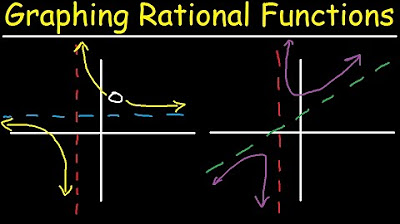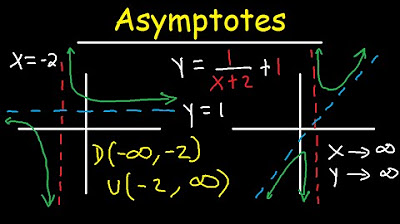Graphing Advanced Rational Functions With Asymptotes and Holes Using Transformations
TLDRThis educational video script delves into the advanced concepts of graphing rational functions. It guides viewers through identifying horizontal and vertical asymptotes, holes, and intercepts to sketch accurate graphs. The script covers multiple examples, demonstrating how to factor and simplify rational expressions, use long division to find slant asymptotes, and plot points to determine the function's domain and range. The lesson emphasizes the importance of understanding the behavior of rational functions and provides practical steps to visualize their graphs, catering to students looking to enhance their mathematical graphing skills.
Takeaways
- 📚 The lesson focuses on graphing advanced rational functions and uses specific examples to illustrate the process.
- 🔍 To graph a rational function, one must first identify horizontal and vertical asymptotes, as well as any holes in the graph.
- 👉 For a 'bottom heavy' rational function (denominator's degree > numerator's), the horizontal asymptote is y=0.
- ✂️ Vertical asymptotes are found by factoring the denominator and setting the non-canceling factors equal to zero.
- 🔍 To find the y-value of a hole, substitute the x-coordinate of the hole into the simplified rational function.
- 📈 The domain of a rational function is all real numbers except where the function is undefined (e.g., at vertical asymptotes or holes).
- 📉 The range of a function is determined by considering the horizontal asymptote and the y-values that the function does not reach.
- 📊 For functions with the same degree in the numerator and denominator, the horizontal asymptote is found by dividing the leading coefficients.
- 📐 Slant (or oblique) asymptotes occur when the degree of the numerator is exactly one more than the degree of the denominator and are found using polynomial long division.
- 📍 X and y-intercepts are found by setting y=0 and x=0 respectively, and solving for the other variable.
- 📘 The script provides step-by-step instructions for graphing rational functions, including how to handle special cases like holes and slant asymptotes.
Q & A
What is the horizontal asymptote for a rational function where the degree of the denominator is greater than the numerator?
-The horizontal asymptote for such a rational function is y equals zero.
How do you find the vertical asymptote of a rational function?
-To find the vertical asymptote, factor the denominator and set the factor that does not cancel out equal to zero.
What is a hole in the graph of a rational function, and how can it be identified?
-A hole is a point where a factor in the numerator and denominator cancels out. It is identified by setting the cancelled factor equal to zero and finding the x-coordinate of the hole.
Can you provide an example of how to find the y-value of a hole in a rational function?
-Yes, to find the y-value of a hole, plug the x-coordinate of the hole into the simplified rational function after the cancelling factor has been removed.
What is the domain of a rational function with a vertical asymptote at x equals 3 and a hole at x equals -2?
-The domain would be all real numbers from negative infinity to -2, then from -2 to 3, and from 3 to infinity, written in interval notation as (-∞, -2) ∪ (-2, 3) ∪ (3, ∞).
How do you find the range of a rational function with a horizontal asymptote at y equals zero and a hole at x equals -2?
-The range would be all real numbers from negative infinity to the y-value of the hole (negative one-fifth), then from the y-value of the hole to zero, and from zero to infinity, written in interval notation as (-∞, -1/5) ∪ (-1/5, 0) ∪ (0, ∞).
What is the significance of finding the y-intercept of a rational function?
-The y-intercept is the point where the graph of the function crosses the y-axis. To find it, set x equal to zero in the function and solve for y.
How can you determine the x-intercept of a rational function?
-To find the x-intercept, set y equal to zero and solve the resulting equation for x. This will give you the x-coordinates where the function crosses the x-axis.
What is a slant asymptote, and how does it differ from a horizontal asymptote?
-A slant asymptote is a line that the graph of a rational function approaches but never touches, occurring when the degree of the numerator is exactly one more than the degree of the denominator. A horizontal asymptote is a horizontal line that the graph approaches, which occurs when the degree of the numerator is less than or equal to the degree of the denominator.
Can you explain the process of long division used to find the slant asymptote in a rational function?
-Long division is used to divide the numerator by the denominator of the rational function. The quotient from this division represents the slant asymptote of the function.
Outlines
📈 Graphing Rational Functions with Vertical and Horizontal Asymptotes
This paragraph introduces the process of graphing advanced rational functions, starting with an example function (x+2)/(x^2-x-6). The speaker explains how to identify horizontal asymptotes by checking the degrees of the numerator and denominator. For vertical asymptotes, the function is factored, and values that cause the denominator to zero are found. A hole in the graph at x = -2 is identified by canceling a common factor. The y-value of the hole is calculated by substituting x = -2 into the simplified equation. The domain and range of the function are determined by considering the asymptotes and the hole, with the domain in interval notation and the range considering the function's behavior around the hole and asymptotes.
🔍 Factoring and Analyzing Rational Functions for Graphing
The second paragraph continues the graphing lesson with a new function example (x^2-x-2)/(x^2-2x-3). The speaker demonstrates complete factoring of both the numerator and the denominator. A hole at x = -1 is identified, and the y-coordinate of the hole is calculated. The horizontal asymptote is determined by comparing the degrees of the numerator and denominator, resulting in y = 1. The y-intercept is found by setting x to zero, and the x-intercept is calculated by setting y to zero and solving for x. The speaker then guides through graphing the function, plotting the asymptotes, hole, and intercepts, and discusses the domain and range, taking into account the excluded values from the vertical asymptote and the hole.
📚 Understanding Asymptotes and Intercepts in Rational Function Graphs
The third paragraph presents another rational function (1/(x^2-4+2)) and explains the process of factoring to find vertical asymptotes at x = 2 and x = -2. The horizontal asymptote is determined to be y = 2 by considering the degrees of the numerator and denominator and the constant added to the horizontal asymptote. The y-intercept is calculated, and the x-intercepts are found by setting y to zero and solving the resulting quadratic equation. The speaker then sketches the graph, indicating the asymptotes and intercepts, and discusses the domain and range, noting the exclusion of the vertical asymptotes from the domain and the horizontal asymptote from the range.
📉 Graphing Rational Functions with Slant Asymptotes
In this paragraph, the focus shifts to a function with a slant asymptote, y = (x^2-x-2)/(x-3). The speaker explains that since the degree of the numerator exceeds the denominator by one, a slant asymptote exists. Long division is used to find the equation of the slant asymptote, y = x + 2. The function is factored to find that there are no holes, and the vertical asymptote at x = 3 is identified. X-intercepts are calculated by setting the numerator to zero, and the y-intercept is found by substituting x = 0. The speaker then sketches the graph, including the vertical and slant asymptotes, and the intercepts. The domain is determined by excluding the vertical asymptote, and the range is discussed, noting that it may require calculus or a graphing calculator for precise values.
📘 Estimating Domain and Range for Functions with Slant Asymptotes
The final paragraph concludes the lesson with a discussion on estimating the domain and range for the function with a slant asymptote. The domain is straightforward, excluding the vertical asymptote at x = 3. The range is more complex, requiring an understanding of the function's maximum and minimum y-values, which might be estimated or precisely determined with a graphing calculator. The speaker provides an estimated range, noting that the actual values may vary and should be verified with a calculator for accuracy.
Mindmap
Keywords
💡Rational Functions
💡Horizontal Asymptote
💡Vertical Asymptote
💡Factoring
💡Hole
💡Y-Intercept
💡X-Intercept
💡Domain
💡Range
💡Slant Asymptote
Highlights
Introduction to graphing advanced rational functions.
Identifying the horizontal asymptote for bottom-heavy rational functions where the degree of the denominator is greater than the numerator.
Method to find the vertical asymptote by factoring and canceling terms.
Identifying a hole in the graph when a factor cancels out.
Calculating the y-value of the hole by plugging it into the surviving equation.
Graphical representation of the vertical asymptote and horizontal asymptote.
Plotting the hole's location on the graph.
Understanding the domain and range of the function and how to express them in interval notation.
Finding the y-intercept by substituting x with zero.
Using the surviving equation to graph the function's general shape.
Example problem involving factoring and identifying holes and asymptotes.
Calculating the y-value of the hole and the x and y-intercepts.
Graphing the function with identified asymptotes and intercepts.
Determining the domain and range of the graphed function.
Another example with a function that has a slant asymptote.
Using long division to find the slant asymptote.
Identifying x-intercepts by setting the numerator equal to zero.
Finding the y-intercept and plotting it on the graph.
Estimating the domain and range of the function without a horizontal asymptote.
Using a graphing calculator to find the exact maximum and minimum y-values for the range.
Transcripts
Browse More Related Video

Graphing Rational Functions With Vertical, Horizontal & Slant Asymptotes, Holes, Domain & Range

Horizontal and Vertical Asymptotes - Slant / Oblique - Holes - Rational Function - Domain & Range

Graphing Rational Functions with Transformations (Precalculus - College Algebra 39)

Finding Asymptotes and Holes of Rational Functions (Precalculus - College Algebra 43)

Graphing Rational Functions Using Transformations With Vertical and Horizontal Asymptotes

How to graph a rational function using 6 steps
5.0 / 5 (0 votes)
Thanks for rating: